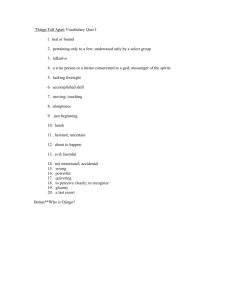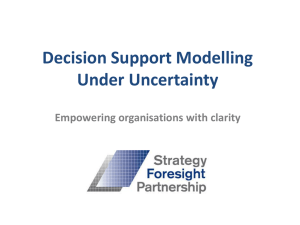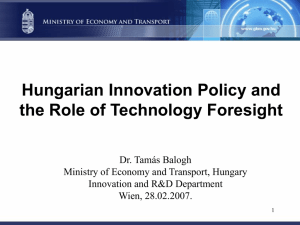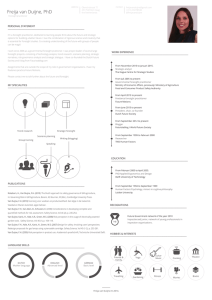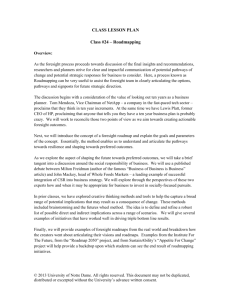Policy Handbook
advertisement
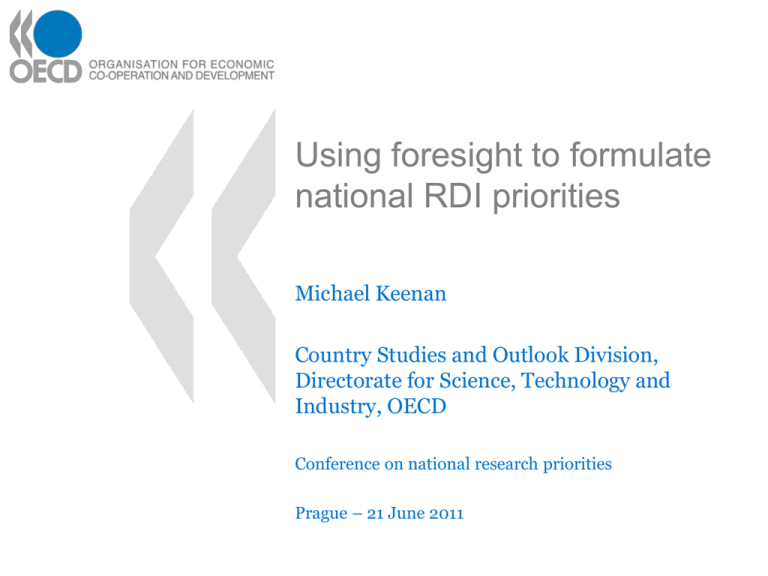
Using foresight to formulate national RDI priorities Michael Keenan Country Studies and Outlook Division, Directorate for Science, Technology and Industry, OECD Conference on national research priorities Prague – 21 June 2011 Some basic definitions to start with . . . • Prioritisation refers to the conscious and deliberate selection of certain activities, actors, policies or policy instruments at the expense of others with an impact on resource allocation • Foresight refers to systematic collective processes of exploring and anticipating the longer term with a view to identifying actions to take today in support of desirable futures • Prioritisation processes involve – Looking backwards to appreciate the evolution of scientific know-how – Understanding current strengths and weaknesses of the research and innovation system – Looking forwards to anticipate and shape future opportunities and challenges What form do RDI priorities take? Structural priorities Research Innovation Thematic priorities Linked S&T areas Issues Priorities at different levels: OECD (1991) proposes three levels: (i) policy (govt) (ii) strategic (research funding agencies) (iii) operational (research performing institutes) In other words, the activity of formulating and implementing S&T priorities tends to be highly decentralised. Why prioritisation? • Competing demands on S&T budgets – ‘internal’ scientific ‘excellence’ criteria alone would seem to be insufficient to limit the number of projects to the resources available. So other ‘external’ criteria – often oriented around ‘relevance’ – need to be employed • In addition, governments now view S&T as key determinants in the development of knowledge economies and these are viewed as requiring strategic steering • Concerns over the so-called innovation gap (particularly in Europe) mean that scientists alone cannot take the decision of which areas are to be pursued. Rather, this decision-making process needs to be opened-up to other actors in innovation processes • Conclusion: we need to instigate a process that will identify strategic S&T priorities, ‘strategic’ in the sense that priorities will contribute towards innovation. Moreover, this process needs to involve a widerange of actors, reflecting the nature of the innovation process. Contributions of research to innovation (1) • The main channels of interaction between research and innovation include the following: – – – – – – – Scientific record Technological development Mobility R&D collaboration Knowledge markets Spin-offs Advice, consultancy and extension • Several different actors are key in the operation of these channels • The ways in which these key actors conduct themselves are influenced by multiple shaping factors • Policies work by modulating these shaping factors and by influencing key actors directly Core Policies Discretionary organisational funding Shaping Factors Competitive R&D project grants Economic Development Support for R&D infrastructures Researchers Economic Specialisation Centres of excellence Research Universities Industrial Ecology Research > Innovation Public Research Institutes Geography Collaborative R&D programmes Scientific Record Scientific Unions Financial Markets Technology platforms Technological Development Technology Transfer Offices Scope and Scale of Public Research Cluster initiatives Mobility Large Domestic Firms R&D Collaboration Large Foreign Firms Public Research Specialisation Knowledge Markets Traditional SMEs Labour Market Regulation University-industry linkage schemes Spin-offs High-tech SMEs Academic Careers PhD studentships Advice, Consultancy and Extension Regulatory Organisations PSR Funding Regimes Post-doctoral fellowships Funding Organisations IPR Regimes Inter-sectoral mobility schemes Policy-Making Organisations Roles and Status of HEIs/PRIs Third Sector Organisations Scientific Community Norms Key Actors Open Innovation Science and technology parks Risk capital measures in support of spin-offs Entrepreneurship training schemes Technology diffusion schemes Examples of key actors, shaping factors and core research policies Innovation vouchers Technology incubators Contributions of research to innovation (2) Shaping factors Research activities Policies Innovation performance Actors All of these components can be subject to prioritisation and/or shape the implementation of priorities Attractiveness UK Foresight Prioritisation Criteria Economic and social needs Opportunities and threats Scientific and technological opportunities Feasibility Panel Strategic analysis Potential to apply (industrial strength) Strengths and weaknesses Scientific and technological strengths Attractiveness vs. Feasibility Matrix UK Technology Strategy Board Priority Criteria The degree to which technologies will have an impact on sectors that are a major UK strength (e.g. pharmaceuticals and aerospace) or have high growth potential; The degree to which a particular technology will have an impact on a number of sectors; Strength of the UK SET base relative to other countries; Potential economic, social, quality of life and environmental benefits and scope for cross-government collaboration (e.g. healthcare, energy); Potential for spillover benefits and whether there is an underpinning market failure; and The degree to which there is scope for effective action by Government or others. The importance of an international perspective • • • • • • Internationalisation of science Position of firms in global value chains Open innovation Global challenges Accessing international knowledge – absorptive capacity International benchmarking to determine relative strengths and weaknesses • International policy learning Assessment criteria and their operationalisation • How to assess whether a given scientific or technical area will further the pursuit of economic goals and social values more / less than any other area? In other words, can S&T areas be assessed against the criteria often deployed in foresight and priority-setting exercises? – This is very difficult to do by the lone expert, not least on account of the expert’s limited knowledge of the various fields. – But the inherent uncertainty around such outcomes – a manifestation of a complex system – also often makes this a difficult and unreliable assessment. • These inherent uncertainties cannot be ‘engineered away’ through methodology. There is the need to embrace social, discursive approaches that provide access to decision forums by a wide variety of actors. – This isn’t easy and certainly doesn’t provide a panacea. – It will also be uncomfortable for existing elites who may try to undermine any such moves. Common challenges in priority-setting • Granularity / aggregation of thematic areas • Criteria – absorptive capacity, critical mass, variety – at what levels of aggregation do we want these? • Viewing thematic and structural priorities in constellations • Expertise to compare apples with pears • Participation – who, how, when? • Dealing with complexity and emergence • Organisational positioning – outside/inside, safe space, boundaryspanning • Paying attention to process / product • Understanding the implementation context • Path dependency and lock-in • Transparent ‘audit trail’ – for purposes of accountability, but also to signal appropriate intervention strategies FORESIGHT FOR PRIORITYSETTING What does a Foresight exercise look like? • Many shapes and sizes! • Common aspects: experts, panels, project team, fixed budget and time, sponsor, reporting and recommendations • Typical variations: methods used, methodological sophistication, degree of participation, budget and time available, time horizon, coverage, organisational configuration, etc. Who sponsors / carries out foresight exercises? • • • • • • • • • • • Ministries and other government agencies Research Councils Academies of Science and other research institutes Universities Regional Development Agencies Industry Clusters Large companies Industry Federations Private Foundations International Organisations … Essentially, virtually any organisation can sponsor a foresight exercise Foresight uses in policy FORESIGHT AS POLICY INFORMATION Highlights the longer term Extends perspectives => More rational decision making over space and time FORESIGHT AS ADVOCACY COALITION-BUILDING Highlights a given challenge Gathers support around it => Commitment to realisation of a shared vision FORESIGHT AS SOCIAL TECHNOLOGY Old debates, new frames Wide participation => Hybrid fora for strategic reflection, debate & action Orientation of Foresight PRODUCT/ CODIFIED OUTPUT MIXED PROCESS/ NETWORK, TACIT OUTPUTS Priority implementation • • • • Organising the implementation of priorities can be an integral part of the priority-setting process itself. There are a variety of intervention strategies open if an area scores poorly on its feasibility ranking. Indeed, if the aim of the exercise is to identify areas that need to be strengthened, then it may be that only these areas are prioritised whilst the rest of the S&T base continues as before. This depends on how the feasibility ranking was arrived at Resources are needed to ensure that priorities are not a ‘dead letter’. Furthermore, in the case of thematic priorities, there needs to be a scientific and technological community of adequate size and skills in any selected field if objectives are to be met. This is important to bear in mind, since fields are frequently given priority status for the very reason that existing R&D activity and capabilities are weak. The most frequent response to this problem is to combine thematic and structural priorities (e.g. training of young researchers, encouragement of foreign research groups to relocate, etc.). But implementation won’t happen overnight, irrespective of the resources devoted to any priority. It takes considerable time to train new scientists and engineers, to improve skills, to strengthen networks, and to constitute a scientific and technological community. Impacts to expect • Foresight as policy information – Decisions, resource allocations • Foresight as advocacy coalition building – New agenda formation, actor alignment and mobilisation • Foresight as social technology – Broadened participation, new networks and communities Attributes for policy impacts (Martin, 1996) • Authority – endorsement by and support of senior public officials and corporate representatives is necessary for exercise to be regarded as a matter of sufficient importance to influence decision-making • Legitimacy – involvement of all relevant stakeholders and avoiding undue influence by vested interests • Credibility – results should be informative and well-founded, necessitating the use of rigorous and transparent methods Thinking some more about impacts . . . • Need to take a broad view of WHAT constitutes an impact and WHERE it might be found – WHAT: tangibles and intangibles and their interdependency – WHERE: systemic view • Requires an understanding of policy, business, innovation, etc. processes • But also an appreciation of the scope of intervention that is possible with foresight • Incrementalism • Impacts over time • Challenge of measuring impacts • Selling the benefits of foresight and expectation management Being realistic . . . • Radical policy change – foresight as a source of punctuation (disturbance / disruption) in otherwise path-dependent incremental policy change, e.g. through the detection of weak signals, the formation of new actor coalitions, etc. • Impacts dependent upon innovation system properties: in those that are fragmented, foresight can serve to foster linkages and enhanced social learning; in those that are ‘wired-up’ by close linkages, foresight can act as a useful disruptor (though its impact will depend on how much strategic intelligence the system already has at its disposal) Reported Impacts of foresight • • • • • • • • • • • • • • • • • • • • Better informed strategies in general Making the case for increased investments in R&D Using foresight results to evaluate and future-proof strategies More informed STI priorities Development of new ways of thinking Creating a language and practice for thinking about the future Highlighting the need for a systemic approach to both policymaking and innovation Development of reference material for policymakers and other innovation actors Better evidence-based policy A source of inspiration for non-governmental actors Creation of new networks and clusters Establishment of communication structures between innovation actors Collective learning through an open exchange of experiences Enhanced reputational position and positive image of those regions running a foresight Better visibilities of a region’s strengths and competencies Interest from the general public Achievement of long-term reform of the productive system through a raised emphasis on high technology Accumulation of experience in using foresight tools and thinking actively about the future Stimulation of others to conduct their own foresight exercises after being inspired … Designing for impacts • Keep in mind impacts – and the ways you are going to attain them – from the outset of the exercise, i.e. ensure you are outcomesoriented rather than outputs-oriented (a common error in foresight, for example) • Pay attention to the process – the source of many impacts • Have a dedicated communications strategy • Generate codified outputs that are informative and attractive to their target audiences • Build in an ‘aftercare’ phase – the results are unlikely to ‘speak for themselves’, and the target audience may need assistance in making sense of the results for themselves • Above all else, be realistic as to what can be achieved, and understand the mechanisms through which you expect your process to have impacts Major challenges for the Foresight manager / practitioner • Keeping within time and budget – project management skills, but also political skills • Avoiding ‘BOGSAT’ by genuinely opening up the process, especially to different perspectives • Dealing with short-termism, i.e. a failure to look sufficiently forwards (or backwards) • Evidence-based – collecting, circulating and digesting information • Getting people to act as individuals rather than as representatives • Instilling creative thinking • Unfamiliarity with some foresight methods • Ensuring sustained participation • Managing expectations of (policy) impacts • Remaining relevant whilst pushing the boundaries Impressions of problems with foresight • • • • • • • • • • Limited vision => lock-ins, “me-too” behaviours, … Limited (or tokenistic) participation Limited integration of knowledge => novelty? Limited data Vision too vague or abstract for action Too much ‘reinventing the wheel’ – foresight shares many characteristics of other strategic practices But also inappropriate transfer from one setting to another Lack of appreciation of innovation and policy systems and the way they work Disconnection from ‘real’ centres of power – legitimacy? Managing (unrealistic) expectations: long-haul view Delineating principles of good practice • Matching approach to objectives and context • Learning from elsewhere, but being sensitive to the differences between localities • Being adaptive in managing a foresight exercise • Taking a systems view of foresight and its context • Appreciating the mechanisms through which foresight ‘works’, e.g. learning, vision-building, agenda-setting, actormobilisation, etc. in addition to the systematic (rational?) ordering of preferences and priorities • Accepting that there is no ready-made formula for conducting a successful foresight exercise • Being patient for impacts to occur, and appreciating that many will be difficult to attribute (solely) to the foresight exercise itself Thank you! Michael.Keenan@oecd.org

